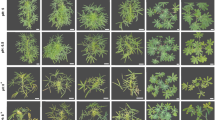Summary
In a greenhouse pot study eight finely ground rock phosphates, representing a wide range of geographic origin and citrate solubility, were compared with granular triple superphosphate as sources of P for newly germinated slash pine (Pinus elliottii Engelm.) seedlings. Two acid and P-deficient soils broadly representative of the forest soils of the southeastern U.S. were used in the evaluation.
In a Weston fine sandy loam, dry matter production and P uptake in the first seedling crop were strongly positively correlated with citrate solubility of the P source. Increasing P application rates among sources of higher solubility resulted in marked increases in tree response. In the second seedling crop, differences among sources followed the same trends, generally, but were much less pronounced. In the third crop, differences among sources virtually disappeared.
In a Davidson silty clay loam, P source effectiveness for the first crop was again positively correlated with citrate solubility but differences among P sources were smaller than in Weston. At low P application rates, plant response was greater, but increasing P rates to very high levels did not bring about corresponding increases in growth and P uptake as in the Weston soil. In the second crop, a disorder diagnosed as Mn toxicity, induced by increasing soil acidity, severely retarded seedling growth and precluded the continuation of the bioassay on this soil.
The results indicate that citrate solubility is a useful chemical property for rating early effectiveness of rock phosphates used in direct application to forest trees on acid soils. Long-term field trials on different soils will be required to determine the importance of this initial solubility to the overall performance (i.e., both early and sustained growth) of the tree crop and to evaluate the effects of soil characteristics and supplemental fertilizer treatments which may modify tree response to different P sources. re]19730406
Similar content being viewed by others
References
Bengtson, G. W., Placement influences the effectiveness of phosphates for pine seedlings. In: Tree Growth and Forest Soils. Oregon State Univ. Press. pp. 51–63 (1970).
Bengtson, G. W., Trends in forest fertilization. In: Searching the Seventies. TVA Fert. Prod. and Market. Conf. pp. 72–77 (1971).
Ensminger, L. E., Pearson, R. W., and Arminger, W. H., Effectiveness of rock phosphate as a source of phosphorus for plants. USDA-ARS Bull. 41–125. 40 pp. (1967).
Gentle, S. W., Humphreys, F. R., and Lambert, Marcia J. An examination of Pinus radiata phosphate fertilizer trial fifteen years after treatment. (1965). Forest Sci. 11, 315–324.
Gentle, S. W. and Humphreys, F. R., Experience with phosphatic fertilizers in man-made forests or Pinus radiata in New South Wales. 9th Commonwealth Forestry Conf., India. 36 pp. (1968).
Goor, C. P.van., Phosphate Requirements of Trees and Phosphate Fertilization of Forest. Bosbouwproefstation, Wageningen. pp. 251–257 (1953).
Heikurainen, L., The effects of manuring on organic soils. In: Proc. of the Colloquium on Forest Fertilization. Int'l. Potash Inst., Jyväskylä, Finland. pp. 197–205 (1967).
Humphreys, F. R. and Pritchett, W. L., Phosphorus adsorption and movement in some sandy forest soils. Soil Science Soc. Am. Proc. 35, 495–500 (1971).
Lehr, J. R. and McClellan, G. H., A revised laboratory reactivity scale for evaluating phosphate rocks for direct application. Bull. Y-43. TVA Nat. Fert. Dev. Center, Muscle Shoals, Ala. 36 pp. (1972).
Maugé, J. P., Études et expérimentations sur pin maritime 1965–1970. Assoc. 061 Foret-Cellulose (AFOCEL), Paris. 74 pp. (1970).
O'Hare, P. J., Leader growth and foliar composition in Sitka spruce (Picea sitchensis Carr.) in relation to fertilizer application on blanket peat. In. Proc. of the Colloquium on Forest Fertilization, Int'l. Potash Inst., Jyväskylä, Finland, pp. 111–121 (1967).
Pritchett, W. L., Slash pine growth during the seven to ten years after fertilizing young plantations. Soil Crop Sci. Soc. Florida 29, 34–44 (1970).
Pritchett, W. L. and Swinford, K. R., Response of slash pine to colloidal phosphate fertilization. Soil Sci. Soc. Am. Proc. 25, 397–400 (1961).
Pritchett, W. L. and Smith, W. H., Fertilizing slash pine on sandy soils of the Lower Coastal Plain. Chester T.Youngberg and Charles B.Davey (eds). Proc. 3rd No. Am. Forest Soils Conf., Raleigh, N.C. Publ. by Oregon State Univ. Press, Corvallis. pp. 19–41 (1970).
Terman, G. L., Phosphate fertilizer sources: agronomic effectiveness in relation to chemical and physical properties Fertiliser Soc. Proc. (London) No. 123, 39 pp. (1971)
Young, H. E., The response of loblolly and slash pines to phosphate manures. Queensland Div. Plant Ind. Bull. No. 42. 29 pp. (1948).
Author information
Authors and Affiliations
Rights and permissions
About this article
Cite this article
Bengtson, G.W., Sample, E.C. & Allen, S.E. Response of slash pine seedlings to P sources of varying citrate solubility. Plant Soil 40, 83–96 (1974). https://doi.org/10.1007/BF00011411
Received:
Issue Date:
DOI: https://doi.org/10.1007/BF00011411




